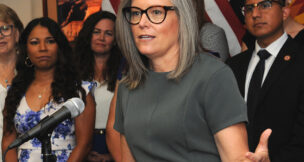Bird Man of Tombstone
Some of Tombstone's most famous gun fighters, including the Earps, Doc Holliday, Billy Claiborne and Johnny Ringo all patronized Hafford Saloon, which became one of the most popular watering holes in Tombstone. But the establishment is notable for another reason entirely.
Paradise, Arizona
In 1940, the year this photograph was taken, an unidentified scribe noted "a score of weather-worn frame buildings scattered along the narrow, winding mountain road" that snakes through Paradise.
Baron of Arizona
When it came to an appetite for ill-gotten gains, James Addison Reavis, the self-proclaimed Baron of Arizona, was in a class by himself.
3 generations of photographers in the Old Pueblo
Arriving in Tucson seven years before the railroad, frontier photographer Henry Buehman captured the rapidly vanishing frontier on film. His son Albert Buehman continued the family tradition and gained international renown. Grandson Remick rounded out an 80-year family legacy.
Tucson Fire Department
The Tucson Fire Association, Tucson Fire Company and Tucson Hook and Ladder Company formed the first Tucson fire department under the fumes of cigar smoke in the Gem Saloon on Congress Street in the early 1880s. While the volunteers had the will to fight fires, technology and city support still needed to catch up.
The prowl of the ‘Velvet Tigress’
Leading up to Halloween in 1939, Phoenix was enthralled with the first of several escapes by a female prisoner newspapers delighted in describing as the "Trunk Murderess," "Tiger Woman," "Blond Tigress," "Velvet Tigress" and "Mad Killer."
NAU’s George Washington connection
George Washington assumed command of the Continental Army under an Ulmus Americana Elm tree in Cambridge, Mass., on July 3, 1775. The tree died in October 1923, but foresighted botanists made sure its legacy lived on at universities across the United States, including the campus at Northern Arizona University in Flagstaff.
City-county building
At the end of October of 1929, a $1.5 million (approximately $18.7 million today) structure, described as "...an inspiration for better government and a symbol of progress and prosperity," was dedicated at Central Avenue and Washington Street in downtown Phoenix.
Arizona life circa 1907
In 1907, the territory of Arizona had fewer than 200,000 residents. However, there seemed to be a number of interesting characters that kept the local newspapers busy. In Tucson, "...a jury of 12 good citizens" decided that cowboys and miners coming into town had two hours to remove their weapons.
Tombstone: Fighting frontier fires
Fires were a common occurrence in frontier towns. With limited water supplies and volunteer firefighters, Tombstone almost completely burned to the ground twice. On June 22, 1881, a cigar ignited a barrel of whiskey at the Arcade Saloon. The subsequent fire destroyed more than 60 businesses in the downtown area - comprising the eastern half of Tombstone's business district.
Phoenix baseball hit crossroads in 1950s
In the mid-1950s, the future of baseball in Phoenix seemed to be on the line as the city was trying to purchase Phoenix Municipal Stadium. Allerton Cushman and his wife owned approximately 10 acres around what was then called Phoenix Municipal Stadium at Third and Mohave streets south of downtown Phoenix. The 100 Club owned the Phoenix Senators that played at the stadium.
The short-lived Papago Saguaro National Monument
Shortly after statehood in 1912, the Phoenix and Maricopa County Board of Trade began an effort to have what is now Papago Park declared either a national park or a national monument. Originally, the committee recommended the creation of a "National Cactus Park" just like Yellowstone National Park, the Yosemite National Park and the Mount Rainer National Park."






